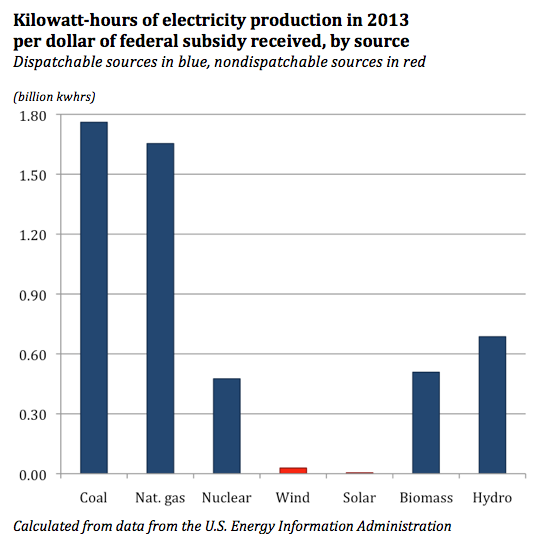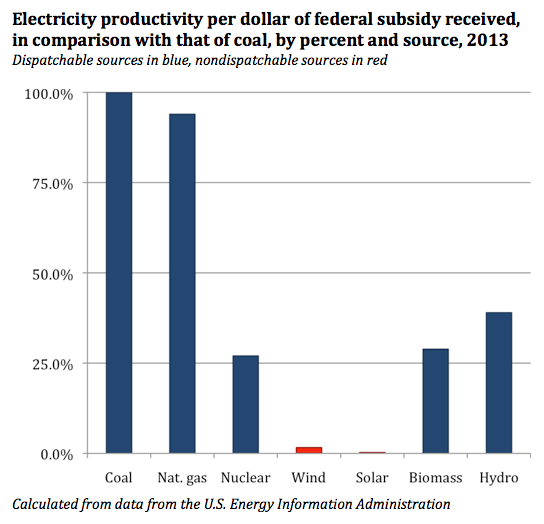Benjamin Zycher writes in the Washington Examiner about the renewable energy industry’s case for getting rid of subsidies for traditional energy sources, and how it harms a good case by then begging for subsidies for renewable energy sources (but not hydro).
Sometimes leftist environmentalists have a point. For instance, they argue that oil subsidies are wasteful and should be abolished. … This anti-oil coalition is absolutely correct that subsidized finance for fossil-fuel projects is highly wasteful.
A note on that point, just ask ratepayers in South Carolina, who might have to pay for unbuilt nuclear reactors for the next 60 years! This is another remind of the dangerous folly of Construction Work in Progress (CWIP), the quid pro quo for Duke Energy buried in the Renewable Energy Portfolio Standards bill of 2007.
But then,
The problem is that in the same breath they attack oil subsidies, Oil Change International, demands subsidies for solar installations and windmills, citing environmental doomsday scenarios to justify this distortion of the public discussion on energy development.
This is yet another example of arguing “That cronyism is bad because it can’t go to this cronyism.” How about no cronyism at all?
In a November 22, 2015, newsletter I wrote, I tackled the question of comparing federal energy subsidies. The graphs became casualties of our web site transition. So if you don’t mind, I will post that newsletter here with the graphs restored. The remainder of this post is that newsletter.
Taking a look at the differing electricity subsidies
A novel justification for governments heavily subsidizing otherwise unsustainable, expensive, inefficient renewable energy is to argue that all energy sources get subsidies. The general assertion is true as far as that goes.
Still, the argument is often used as a variant of “two wrongs make a right” in complementing the insincere “besides, it’s not a free market (so let us plunder)” argument.
A quick caveat: The proper comparison would be of net subsidies
Before proceeding further, I wish to highlight my colleague Dr. Roy Cordato’s work on the proper way to compare energy subsidies, not by looking at gross subsidies, but net subsidies. Why net subsidies are economically more relevant is because they “include not only the monetized value of policies that subsidize the relevant industries but also the monetized value of policies that penalize those industries.” (Emphasis added.)
Cordato’s report lists (pp. 3-4) several examples of subsidies and penalties that should be considered in calculating net subsidies. He concluded,
Energy markets are riddled with government intrusions, from mandates and grants of monopoly privilege to special tax breaks and environmental and land use regulations. All energy sources are both subsidized and penalized. The point to remember is that when we are given comparative estimates regarding energy subsidies alone we are being told an incomplete story. From the perspective of economics, and liberty, the important question is — how are coercive policies distorting supply and demand relative to a free market that reflects actual scarcities, production costs, and consumer preferences?
Subsidies for different energy sources and what they get
That being said, earlier this year the U.S. Energy Information Administration at the request of two U.S. House energy committee chairmen published data on federal subsidies for various energy sources. The data used here from that report are from Fiscal Year 2013, the most recent year given.
First, it is not the case — as is sometimes asserted — that traditional energy sources (coal, natural gas, nuclear) are more subsidized than renewable energy sources. The cardinal opposite is true. Renewable sources are subsidized at several levels greater than traditional sources (see the following graph).

While there is a disparity in the level of subsidies, there is a disparity in the other direction in terms of energy production. Traditional sources are far more productive despite far less subsidization than renewable sources (see the following graph).

If one were to graph different energy sources’ kilowatt-hours per dollar of federal subsidy, the magnitude of these twin disparities (sources’ productivity and their level of subsidies) would become more evident.

Here is how those energy sources’ productivity per dollar of federal electricity subsidy compares with that of coal, the industry most in the crosshairs of the Obama administration:

It is indeed true that all electricity sources receive government subsidies. It is not true that they all receive the same amount, nor that traditional sources receive more than renewable sources.
Furthermore, it is clear that traditional sources — which are far more efficient in electricity productivity in general — are also far more efficient in productivity measured per dollar of federal subsidy received than renewable sources, especially the least reliable, nondispatchable sources of wind and solar.
There is more to this matter than mere government wastefulness, however. The argument doesn’t even account for vast differences in land use by differing energy sources.
Also, as the Institute for Energy Research has shown, yet another negative unintended consequence of heavily subsidizing unsustainable, inefficient nondispatchable electricity sources is risking the shutdown of already established, efficient, dispatchable electric plants — which in terms of levelized cost of electricity are, of course, the most economically efficient, consumer friendly operations by a country mile.


